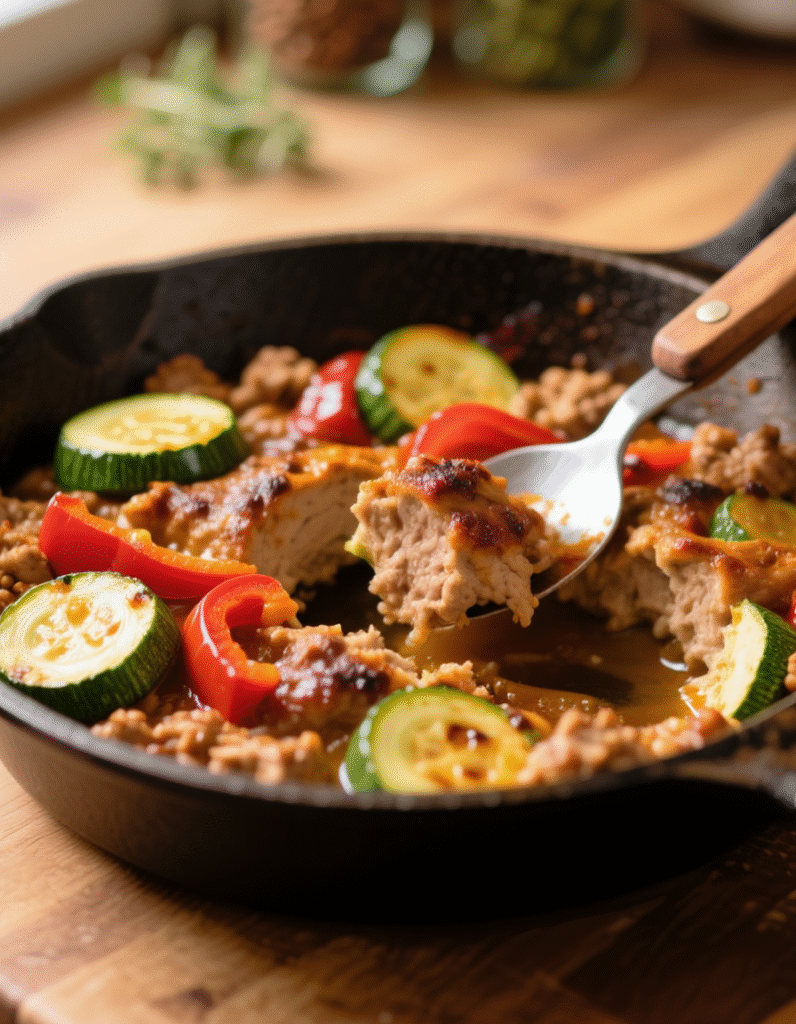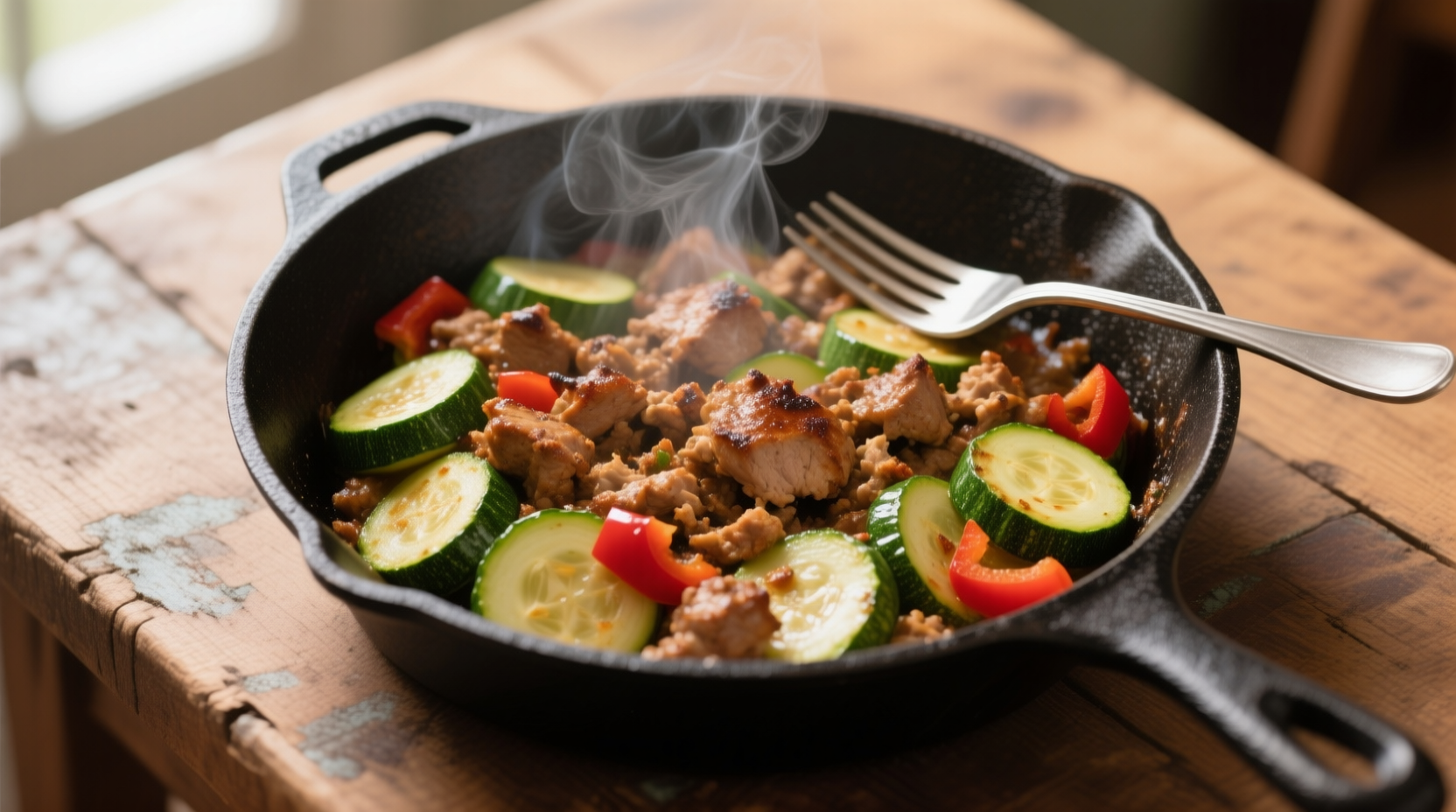Ground turkey and zucchini in a skillet sounds almost too simple. But don’t be fooled. This dish carries more nutritional depth and culinary versatility than many give it credit for. If done right, it becomes that rare weeknight dinner which feels light yet filling, healthy but not boring, and rustic while still refined enough for a chef’s table.
This article takes a deep look at the ground turkey and zucchini skillet recipe, going way beyond the basic “cook and serve.” We’ll talk technique, nutrition, real-world kitchen practices, and the subtle science of flavors. Professional cooks and home chefs alike will find ways to elevate the humble skillet into a dish worth repeating.
Why Ground Turkey and Zucchini Work So Well Together
Turkey breast is naturally lean, often carrying around 7 grams of fat per 4-ounce serving, compared to ground beef which may carry double or more. That leanness, though, often leaves turkey dry and bland. Pair it with zucchini and the story changes. Zucchini has over 90% water content, releasing gentle moisture into the skillet as it cooks. That’s exactly what ground turkey needs.
Think of zucchini as the quiet backstage hand that keeps the star—turkey—from stumbling. Its subtle sweetness and grassy undertone also provide balance to turkey’s mild flavor. A Harvard School of Public Health report highlights lean poultry as a strong alternative protein for lowering cholesterol. Combining it with high-water, fiber-rich vegetables only enhances its health profile.
Professional chefs often look at pairings like this as functional food science rather than just taste. It’s a moisture-fat balance game, and zucchini wins it.
Choosing the Right Ground Turkey
Not all ground turkey is created equal. There’s breast-only, which can be almost fat-free, and there’s thigh-inclusive blends that hover around 15% fat. For skillet cooking, the latter often works best. Too lean, and you end up chasing flavor with oil and butter. A small amount of natural turkey fat means more Maillard reaction—those crisp browned bits that make food exciting.
In commercial kitchens, chefs sometimes blend lean ground turkey with a splash of olive oil or a spoon of chicken stock. It’s not cheating, it’s chemistry. Fat carries flavor compounds and helps emulsify spices. Without it, you’ll struggle with texture and mouthfeel.
Prepping the Zucchini for Success
Zucchini seems simple, but most cooks underestimate its water release. Dice it too small, and it turns into mush. Slice it too thick, and it resists cooking. For skillets, the sweet spot is medium half-moons or small cubes, about ¼ inch thick.
A trick professionals use: salt the zucchini lightly before cooking, then let it rest for 10 minutes. This draws out surface water, making it firmer and less soggy in the pan. Pat it dry and toss it in when the turkey has already developed color. That’s how you avoid the dreaded “watery skillet.”

Building Flavor: Beyond the Basics
Salt, pepper, and garlic might be enough for a Tuesday night. But professionals know layering is everything. Ground turkey can carry big flavors without being overwhelmed. Here are a few tested combinations:
- Mediterranean Profile: Garlic, onion, oregano, paprika, cherry tomatoes, and a crumble of feta at the end.
- Mexican-Inspired: Chili powder, cumin, diced green peppers, corn, and a splash of lime.
- Asian Twist: Ginger, garlic, soy sauce, sesame oil, zucchini, and a final scatter of scallions.
Notice how each profile leans into both moisture and brightness. Zucchini takes seasoning well without fighting for attention, so it’s a perfect co-star.
Technique: The Order of Operations
A skillet recipe is only as good as the cooking sequence. Dump everything in at once and you’ll get steamed meat and soggy vegetables. Professionals think in layers:
- Heat the skillet until oil just shimmers. This ensures meat browns, not steams.
- Add ground turkey, break it apart, and let it sit untouched for a minute. Browning first, always.
- Once color forms, season lightly, then stir.
- Add aromatics like garlic and onions next, so they infuse the browned bits.
- Fold in zucchini toward the end, allowing just enough heat to soften, not disintegrate.
This sequence creates depth of flavor. Those browned turkey bits, called fond, dissolve when zucchini moisture releases, forming a natural sauce without extra cream or broth.
Nutrition: A Skillet That Works for Health
One serving of a ground turkey and zucchini skillet can sit around 250–300 calories, depending on fat content. It offers 25+ grams of protein, high water volume, and decent fiber from zucchini. For professionals in nutrition or culinary wellness programs, this dish fits neatly into high-protein, moderate-carb, and even ketogenic plans.
The American Heart Association often recommends lean poultry for cardiovascular health, while zucchini’s potassium content supports blood pressure regulation. Together, they offer a plate that’s heart-smart and waistline friendly.
Interestingly, professional kitchens with wellness-driven menus often highlight this dish as a gluten-free, dairy-optional option. It’s easily customized without losing structure.
Variations for Professionals to Explore
Chefs rarely repeat a dish in exactly the same form. The ground turkey and zucchini skillet is a blank canvas for regional influence. Here are a few practical variations:
- Italian Lean: Add diced tomatoes, basil, garlic, and parmesan. Serve over polenta.
- Middle Eastern: Toss with cumin, coriander, mint, and finish with a spoonful of Greek yogurt.
- Keto Version: Cook in olive oil with mushrooms, zucchini, spinach, and top with avocado.
- Family-Style Comfort: Add diced potatoes or rice for bulk and season with thyme and rosemary.
Each keeps the structural integrity—turkey for protein, zucchini for balance—but shifts the personality entirely.
Common Mistakes and How to Avoid Them
A frequent error is overcooking both the turkey and zucchini. Turkey turns chalky fast. Zucchini collapses if handled too long. Timing is the shield against both.
Another mistake? Under-seasoning. Because turkey is mild, timid seasoning makes it taste flat. Don’t be shy with spices, acid (like lemon juice), or fresh herbs. A squeeze of citrus at the end almost always wakes the dish up.
Also, watch skillet crowding. If you dump in too much turkey at once, the pan cools, and instead of browning, you steam. Professionals use wide, heavy-bottomed skillets for exactly this reason. Cast iron excels here.

Pairing and Serving Suggestions
A skillet like this rarely stands alone in professional menus. It pairs beautifully with whole grains like quinoa, farro, or brown rice. The nutty base complements turkey’s lightness.
For restaurants focusing on low-carb menus, zucchini noodles or cauliflower rice make natural accompaniments. If plated right—with a drizzle of tahini, yogurt, or even a balsamic glaze—it elevates into a bistro-quality entrée.
Even wine pairing isn’t off-limits. A crisp Sauvignon Blanc complements the fresh zucchini flavors, while a light Pinot Noir balances turkey’s leanness without overpowering.
Emerging Culinary Trend: One-Pan Wellness Meals
There’s a growing trend in culinary practice toward one-pan meals that emphasize nutrient density. The National Restaurant Association’s annual “What’s Hot” culinary forecast has repeatedly placed “healthy comfort food” and “plant-forward proteins” in its top categories.
Ground turkey and zucchini skillets fall directly into this lane. They’re easy to scale, cost-effective for kitchens, and meet diner expectations for both health and taste. Professionals who want to stay ahead of trends will keep variations of this dish in rotation.
Step-by-Step Recipe (Professional Method)
Ingredients (serves 4):
- 1 lb ground turkey (preferably thigh blend, ~93% lean)
- 2 medium zucchinis, halved and sliced
- 1 medium onion, diced
- 2 cloves garlic, minced
- 2 tbsp olive oil
- 1 tsp smoked paprika
- 1 tsp ground cumin
- Salt and black pepper to taste
- Fresh parsley or cilantro for garnish
Method:
- Heat olive oil in a large skillet until shimmering.
- Add turkey, spread it out, and let it brown undisturbed for 2–3 minutes.
- Season with salt, pepper, paprika, and cumin. Stir, breaking apart into crumbles.
- Add onions and garlic. Cook until softened and fragrant.
- Stir in zucchini, cooking 3–5 minutes until tender but still slightly firm.
- Adjust seasoning. Garnish with herbs before serving.
That’s the professional way—browned meat, softened aromatics, vegetables folded in at the right moment. The skillet carries flavor without needing cream or heavy sauces.
Conclusion: Why This Dish Deserves More Respect
Ground turkey and zucchini in a skillet is not just another weeknight dinner shortcut. It’s a textbook example of culinary synergy—protein and vegetable working together, moisture and fat finding balance, flavor unlocking through timing and heat.
For professionals, it’s a dish that showcases efficiency, nutrition, and adaptability. For home cooks, it’s comfort food with a health halo. Whether you lean Mediterranean, Mexican, or minimalist, the foundation remains solid.
If you master just one skillet dish this season, make it this one. It teaches you flavor layering, moisture control, and balance in a way that few “simple” recipes can. The turkey and zucchini skillet may look humble, but in the hands of a thoughtful cook, it becomes something close to perfect.
FAQs
Can I use ground chicken instead of turkey?
Yes, ground chicken works but may be slightly drier, so add a bit more oil or broth.
How do I keep zucchini from turning mushy?
Salt it lightly before cooking and add it near the end for best texture.
What’s the best skillet for this recipe?
A wide cast iron or heavy-bottomed stainless steel skillet gives the best browning.
Is ground turkey healthier than beef?
Yes, it’s leaner and often lower in saturated fat compared to ground beef.
Can I freeze turkey and zucchini skillet?
Yes, but zucchini may soften more after thawing—reheat gently to preserve texture.
What herbs go well with turkey and zucchini?
Parsley, cilantro, basil, and oregano all pair beautifully with this dish.
How do I make this dish low-carb?
Serve it with cauliflower rice or zucchini noodles instead of grains.
Can I make it spicier?
Definitely—add chili flakes, jalapeños, or hot sauce while cooking.
Should I drain the turkey fat?
If it’s very lean, no; if using fattier blends, drain lightly to avoid greasiness.
How long does this skillet recipe take?
Usually 25–30 minutes from start to finish, including prep time.

Mariana is a passionate home cook who creates delicious, easy-to-follow recipes for busy people. From energizing breakfasts to satisfying dinners and indulgent desserts, her dishes are designed to fuel both your body and hustle.
When she’s not in the kitchen, she’s exploring new flavors and dreaming up her next recipe to share with the Foodie Hustle community.

